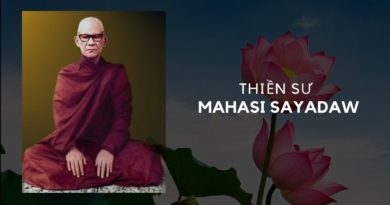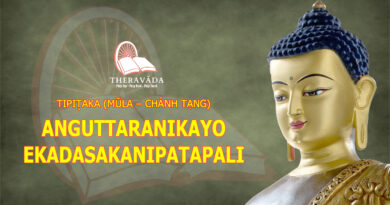The First Discourse Of The Buddha
MAIN CONTENT
-By Mr. S. N. Goenka
(28 July 2007 is the full moon day of Āsādha. It is known as Guru Purnima, meaning full moon day of the teacher, because the Buddha gave his first discourse on this very day in Sarnath.)
At the time of the Buddha, there was a strong belief among some people that one can attain liberation only by leading a life of strict asceticism. In accordance with this view, the Buddha subjected himself to severe austerities for six years. Then realizing the utter futility of self-mortification, he adopted a middle way. Seeing this, his five companions—Kondañña, Bhaddiya, Vappa, Assaji, and Mahānāma—lost confidence in him and deserted him. After enlightenment, the Buddha decided to teach the Dhamma to them first.
When his five former companions saw the Buddha approaching, they decided that they would offer him a seat because he was the son of their ruler but would not show any other sign of respect. But as he came nearer, his infinite love and compassion and the glow on his face attracted them, and they paid full respect to him.
The Turning of the Wheel of Dhamma
The Buddha’s first discourse is called the Dhammacakkappavattana sutta (The Discourse of the Turning of the Wheel of Dhamma). The Buddha gave this discourse to his five former companions at the Deer Park in Isipatana near Benares on the Āsālha- full moon day (July), two months after his enlightenment. In it, the Buddha expounded the Middle Path which he discovered and which forms the essence of his teaching.
At the outset of the discourse, the Buddha said that these two extremes should be avoided by recluses:
Indulgence in sensual pleasures, which is base, vulgar, worldly, ignoble and not beneficial.
Practice of self-mortification, which is painful, ignoble and not beneficial.
Abandoning both these extremes, the Buddha discovered the middle path which leads to enlightenment. This is the Noble Eightfold Path, namely,
1. Right understanding (sammā ditthi)
2. Right thoughts (sammā sankappa)
3. Right speech (sammā vācā)
4. Right action (sammā kammanta)
5. Right livelihood (sammā ājiva)
6. Right effort (sammā vāyāma)
7. Right awareness (sammā sati) and
8. Right concentration (sammā samādhi).
The Four Noble Truths
Then the Buddha expounded the four Noble Truths, which is the essence of his teaching.
1. The Noble Truth of Suffering
Birth is suffering, old age is suffering, disease is suffering, death is suffering, sorrow, lamentation, pain, grief and distress are suffering, association with the unpleasant is suffering, disassociation from the pleasant is suffering, not to get what one desires is suffering; in short, attachment to the five aggregates is suffering.
2. The Noble Truth of the Cause of Suffering
It is this craving that causes rebirth and is bound up with pleasure and lust and finds delight now here, now there. That is, the craving for sensual pleasures, the craving for repeated rebirth and the craving for annihilation.
3. The Noble Truth of the Cessation of Suffering
It is the complete fading away and destruction of this very craving, its forsaking, its renunciation, the liberation from it, leaving no place for it.
4. The Noble Truth of the Path leading to the Cessation of Suffering
It is the Noble Eightfold Path, namely, right understanding, right thought, right speech, right action, right livelihood, right effort, right awareness and right concentration.
Three Aspects of Each Noble Truth
The Buddha explained that he has realized each Noble Truth in three ways:
Acceptance of the nature of each Noble Truth (sacca ñāna),
Intellectual understanding of the effort required for each Noble Truth (kicca ñāna), and
Actual accomplishment of each Noble Truth (kata ñāna).
The Noble Truth of Suffering
One accepts the Noble Truth of Suffering.
One understands that the entire field of suffering should be fully realized at the experiential level—pariññeyya.
One explores the entire mundane field of suffering and transcends it—pariññātam.
The Noble Truth of the Cause of Suffering
One accepts the Noble Truth of the Cause of Suffering, namely, craving.
One understands that this craving should be fully eradicated—pahātabbam
One completely eradicates craving—pahīnam.
The Noble Truth of the Cessation of Suffering
One accepts the Noble Truth of the Cessation of Suffering.
One understands that the state of cessation of suffering should be directly experienced—sacchikātabbam.
One directly experiences the total cessation of suffering—sacchikatam.
The Noble Truth of the Path leading to the Cessation of Suffering
One accepts the Noble Truth of the Path leading to the Cessation of Suffering.
One understands that the Path leading to the Cessation of Suffering should be fully developed—bhāvetabbam.
One has experienced every part of this Eightfold Noble Path; one has developed it to the fullest extent—bhāvitam.
The Buddha declared that he had acknowledged the attainment of the incomparable supreme enlightenment (anuttara sammāsambodhi) only after the absolute true intuitive knowledge regarding the four Noble Truths in three ways (therefore, the twelve modes), had become perfectly clear to him.
Imesu catūsu ariyasaccesu evam tiparivattam dvādasākāram yathā-bhutam ñāna-dassanam suvisuddham ahosi.
-Then there arose in him the knowledge and insight: “Unshakable is the deliverance of my mind; this is my last birth; there is no more existence for me.”
The five disciples rejoiced at these words of the Buddha. At the end of the discourse, Kondañña, the eldest of the five disciples, attaining the first stage of saintliness (sotāppana), realized that whatever is subject to arising is subject to cessation—Yam kiñci samudayadhammam, sabbam tam nirodhadhamman”ti.
Then the Exalted One exclaimed, “Friends, Kondañña has indeed understood!”
* * *
Accepting the truth merely at the devotional level because we have belief in the words of the Buddha or at the intellectual level will not liberate us. We have to realize the truth at the actual level, at the experiential level. This alone will liberate us. Of course, accepting the truth as announced by the liberated person is helpful.
A Buddha’s dassana (wisdom), a Buddha’s ñāna (knowledge), a Buddha’s vimutti (liberation) will give us wonderful inspiration, wonderful guidance. We must make full use of this inspiration, we must make full use of this guidance. Yet it is our own direct experience which will liberate us. Step by step, keep moving towards the final goal with direct experience. No imagination; no blind belief; no dogma; no philosophy. Observe the truth as you experience it from moment to moment—yathā-bhūta-ñāna-dassana. And this is Vipassana: yathā-bhūta-ñāna-dassana.
Keep on developing Vipassana with the base of sīla and samādhi; keep on developing Vipassana to come out of all the bondages, to come out of all the miseries. Make best use of this wonderful Dhamma, this wonderful path. One is so fortunate to get the pure path, the pure Dhamma, the pure technique. You have it; now you have to work. Continue to work diligently.
Bhavatu sabba mangalam—May all beings be happy!
Source: https://www.vridhamma.org







